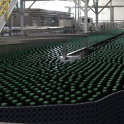|
Scottw330 posted:What kind of heat pad is this? The kind you put on your back when it's sore (heating pad is on the bottom left corner of picture). I was going to buy a little portable heater, but this seems to be maintaining fridge temp at 60 degrees when the garage is around 35-40, which is about as cold as it gets. Fridge is on a separate temperature controller to keep it from getting above 61 degrees. I keep the extra jugs of water as extra heat sinks/add thermal mass between the heating pad and fermenter.
|
|
|
|

|
| # ? May 16, 2024 01:54 |
|
Scottw330 posted:I finally learned how to wax and label bottles! Great job, everything looks amazing. I've tried to do the glue stick and crayon method before but when I dunked the tops, the heat would expand the cap off of the bottle and I would get leakage.
|
|
|
|
WarrenH posted:The party pig makes it a little easier, though, when I remember to order pressure pouches: I think the only thing stopping me from buying it was that I had no idea if I could keep getting the consumable pressure pouches later, or it'd be useless if those guys went out of business. But then again the thing is only 50 bucks so it's not like I'm out a whole lot.
|
|
|
|
kitten smoothie posted:How do you like the Party Pig? I had been mulling it over because I really have no room in my house for a keg fridge. I do have a large-ish mini fridge that I use for bottles (of things I did make and things I didn't) and it seems like it would fit in there and reduce my bottling burden in half. I think it's a good stop-gap until I get my kegging gear (which may be never) and I usually fill a pig with each batch, taking the place of about a case of bottling. Almost $5 per pouch, though, so it probably doesn't make much economic sense over time. It's so convenient, though, that I don't mind the little extra expense, and the little carrying cases are pretty slick and make transporting a breeze. I bought my first party pig in the late 1990s and their website says they're celebrating their 20th anniversary, so I wouldn't be too worried about them going out of business anytime soon. I usually get replacement pouches from whatever website I'm using to order ingredients to minimize extra shipping costs, but you can also get them directly from http://www.partypig.com/Home.aspx.
|
|
|
|
WarrenH posted:I think it's a good stop-gap until I get my kegging gear (which may be never) and I usually fill a pig with each batch, taking the place of about a case of bottling. Almost $5 per pouch, though, so it probably doesn't make much economic sense over time. It's so convenient, though, that I don't mind the little extra expense, and the little carrying cases are pretty slick and make transporting a breeze. Cool, I'll pick one up then. If I get to kegging it will probably be several years from now so this would be a reasonable fill-in. $5 for consumables is well worth it to me to only have to fill half as many bottles. How do you deal with priming it? I normally use 3-4 oz of corn sugar to prime for a 5 gallon batch. Can I boil up the priming sugar with water, mix it all in the bottling bucket as if I were going to bottle it all, then siphon out enough for the party pig?
|
|
|
|
kitten smoothie posted:Cool, I'll pick one up then. If I get to kegging it will probably be several years from now so this would be a reasonable fill-in. $5 for consumables is well worth it to me to only have to fill half as many bottles. I use one of the brewing apps on my phone to determine amount of priming sugar based on desired carbonation for the style and beer temperature at bottling. Basically they all do the same thing as the nomograph on http://www.howtobrew.com/section1/chapter11-4.html The party pig web site and literature they provide says to prime less then you would during normal bottling, which doesn't make sense to me. Carbonation level/CO2 concentration shouldn't be based on your storing/serving vessel. When using the party pig, I've always primed the whole 5 gallons like I would for normal bottling in the bottling bucket then just fill the pig first and put the remainder in bottles. Never had a problem with too much foam when dispensing from the pig doing it this way.
|
|
|
|
I'm on my 2nd batch of homebrew, and unlike the first batch I boiled my top-up water for sanitary purposes. Unfortunately I didn't cool it enough first (partial boil extract, dry yeast). The fermenter has been sitting in the bathtup for 3 hours now and its only down to 87 degrees. I've gone through everything frozen in the house too, to get the bath below tap temps (which are pretty cold here anyway). From what I've read, I guess it's not a big deal to just go pitch the yeast tomorrow, but there's just one problem. I mis-calculated and rehydrated the yeast about an hour ago. So... what's worse, pitching too hot, or leaving the yeast out overnight (it's been covered with sanitized saran wrap)? Edit: Googling tells me both are no-nos  Other options? Other options?- Get new yeast. Unfortunately nothing's open until Tuesday. That would put a mininmum of 58 hours from boil to pitching. - Pitch (in the morning) liquid wyeast hefeweizen yeast I picked up for my next batch. Doesn't match this style (IPA) but I could grab another pack before I was planning on starting the next brew - so I do have some other yeast on hand. - Feed the dry yeast overnight? I have Wheat DME, dextrose, and table sugar. SurgicalOntologist fucked around with this message at 09:06 on Feb 26, 2012 |
|
|
|
theDoubleH posted:I'm on my 2nd batch of homebrew, and unlike the first batch I boiled my top-up water for sanitary purposes. Unfortunately I didn't cool it enough first (partial boil extract, dry yeast). The fermenter has been sitting in the bathtup for 3 hours now and its only down to 87 degrees. I've gone through everything frozen in the house too, to get the bath below tap temps (which are pretty cold here anyway). I would have thought if you just kept at it, you could get the temps down. 87 isn't that far away from pitching temps, like what, 15 degrees? A lot of people just use constantly circulating tap water from what I can tell. I didn't even have ice at all for my first batch and just stuck it in the tub with a fuckton of running cold water.
|
|
|
|
Yeah it just took a couple more hours to get down to 70-72. Hopefully my yeast was still alive, we'll find out soon enough. Edit: somehow my OG came out 4 points higher than BeerSmith estimated. This shouldn't be possible with an extract brew, right? I used 1 lb Crystal, 1 lb Candi Sugar, and 6.6 pounds Amber LME in a 5 gallon batch. BeerSmith says 1.056, I measured 1.060 from two different samples. I don't think my batch size is off by enough to make up the difference (1/3 gallon). Only other thing I can think of is that the ingredient parameters in BeerSmith are wrong. What's the likelihood of this? SurgicalOntologist fucked around with this message at 17:31 on Feb 26, 2012 |
|
|
|
theDoubleH posted:Yeah it just took a couple more hours to get down to 70-72. Hopefully my yeast was still alive, we'll find out soon enough. 1/3 gallon is exactly right for 4 points with these fermentables. You can check with beersmith yourself, change your batch size to 4.66 gal, and watch the OG go to 1.060.
|
|
|
|
Racked my first solo brew into the secondary today, along with about 5 mangoes worth of...um...mangoes. It might be a colossal failure (used the American wheat recipe from Northern Brewer,) but we'll see how it turns out. Assuming my OG was what the recipe said it should be (1.043 (I didn't have a hydrometer at the time,)) I'm at ~4% ABV right now, with the SG today being 1.012. Not sure how much the fruit will impact that.
|
|
|
|
TenjouUtena posted:1/3 gallon is exactly right for 4 points with these fermentables. You can check with beersmith yourself, change your batch size to 4.66 gal, and watch the OG go to 1.060. That's how I got the 1/3 figure. What I meant to say is "no way my batch size is 1/3 gallon off from 5 gallons." I would say its within .05 of the 5 gallon mark. \/ Thanks! SurgicalOntologist fucked around with this message at 22:00 on Feb 26, 2012 |
|
|
|
There's efficiency associated with steeping. Maybe your sample temp isn't where you think it is. Maybe the hydrometer is sticking to the wall a bit. 4 points ain't nothing but a thing.
|
|
|
|
Did my first All-Grain brew last night (at like 3 am  ). It seemed to go well, but I don't think I calculated either my sparge water or my boil off correctly at all (or had way to strong of a boil) since I ended up with like 4 1/4 gallons in the fermenter. ). It seemed to go well, but I don't think I calculated either my sparge water or my boil off correctly at all (or had way to strong of a boil) since I ended up with like 4 1/4 gallons in the fermenter.  I also had no clue at all how to separate the hops and such from the rest of the material and jury rigged a bunch of solutions that didn't really work. My original plan was really just to open the valve and put it in the fermenter but I never considered the valve on the kettle wasn't the same ID as the rest of my hi-temp tubes, so I had to just use the auto siphon. Oh well. Also: turning on the wort chiller and walking off is a good way for chilling to take a loving long time.
|
|
|
|
So I need to know if I'm screwed here. First off I brewed a batch of oatmeal stout with WLP023, and after a full day of active fermentation, it was only a 2 inch krausen so I figured I could switch from blowoff hose to 3-piece airlock. bad idea, as the next day it apparently gushed out of airlock to the point it SHOT off the cap and hood over three feet away. Any chance this one got infected? BUT WAIT, THERE'S MORE! so when i discovered this mess, I wanted to get a clear airlock on it ASAP, and my raspberry melomel had been sitting right next to the stout in a carbouy, it had been sitting in the fermenter a solid six weeks, and has shown like no activity for two weeks. I figured it was full on in the conditioning phase, so I took the airlock off that to use for the stout, and replaced it with a solid plug. Now, I'm gone for two days and come back to the plug apparently having been popped off. I have no idea when it happened in that two day period. Basically with this is there any chance there was enough outward co2 pressure to prevent infection or oxidation?
|
|
|
|
Darth Goku Jr posted:So I need to know if I'm screwed here. There is definitely a chance that it got infected but there's really no way to tell immediately. All you can do at this point is watch and wait. Just keep a close watch on the carboy to see if there's any obvious growth that doesn't look like yeast. After most of the fermentation is finished I would take a little sample and taste it (if it smells OK) to see if it was infected with Lactobacillus or Brettanomyces or whatever which will produce a sour/off taste in your beer. I've heard many stories of this happening all with mixed results. Sometimes it's fine and sometimes your hosed. Darth Goku Jr posted:so when i discovered this mess, I wanted to get a clear airlock on it ASAP, and my raspberry melomel had been sitting right next to the stout in a carbouy, it had been sitting in the fermenter a solid six weeks, and has shown like no activity for two weeks. I figured it was full on in the conditioning phase, so I took the airlock off that to use for the stout, and replaced it with a solid plug. Now, I'm gone for two days and come back to the plug apparently having been popped off. I have no idea when it happened in that two day period. Basically with this is there any chance there was enough outward co2 pressure to prevent infection or oxidation? I've never heard of beer fermenting for this long without putting in some sort of secondary fermentables especially to blow off the plug at six weeks. There is definitely some oxidation that went on but probably not enough to be concerned about. Did you add some fruit or something in there after fermentation?
|
|
|
|
Darth Goku Jr posted:So I need to know if I'm screwed here.
|
|
|
|
Darth Goku Jr posted:You are fine - for future reference, don't use a solid plug even when conditioning - there is almost always some left over co2 etc that will want to get out.
|
|
|
|
Anybody ever put their beer into a minikeg? Like the ones Bell's puts out: I've got a bunch that I've been keeping for...who knows why (they look cool), but I'm getting kind of sick of them, especially one I have duplicates of. I'm wondering if there is a way I could reuse one with homebrew. Has anyone ever done this? Or if you have any other bright ideas for the minikegs, I'd love to hear it.
|
|
|
|
Jacobey000 posted:You are fine - for future reference, don't use a solid plug even when conditioning - there is almost always some left over co2 etc that will want to get out. Believe me I won't.
|
|
|
|
Sirotan posted:Anybody ever put their beer into a minikeg? Like the ones Bell's puts out: This thread should answer all of your questions about mini-kegs. To make them usable requires some work and around $30 worth of parts. I'm sure there are cheaper methods http://forum.northernbrewer.com/viewtopic.php?f=3&t=61167
|
|
|
|
Cask vs. keg. I know practically nothing about the differences except kegging requires CO2 and cask requires...sugar. I'm getting the idea that cask is more like putting your beer in a large bottle with a tap, and as such has a shorter shelf life. Also seems like a lower barrier to entry and cheaper in the long run. Who here puts their beer on cask? Why should I, or should I not?
|
|
|
|
wattershed posted:Cask vs. keg. I know practically nothing about the differences except kegging requires CO2 and cask requires...sugar. I'm getting the idea that cask is more like putting your beer in a large bottle with a tap, and as such has a shorter shelf life. Also seems like a lower barrier to entry and cheaper in the long run. Keeping beer in a cask is for old British guys stuck in a 1970s mindset that only cask ale is "real." (Consider that at the time CAMRA formed, there literally was no craft beer movement anywhere so they didn't have any concept of good kegged beer.) It's a pain in the rear end even for bars to do it since they have to be stored separately from the rest of the kegs and casks don't have any counterpressure to keep the carbonation in, so they rapidly go flat and oxidize the moment you tap them. Think of a kegger when you were in college where the beer was just handpumped and went flat/stale after a few hours. It's roughly the same concept with cask ale; there's a reason only nutters like CAMRA think cask ale is something more than a curiosity. You can buy the pins and firkins that pros use, but buying one + the taps is about 200 dollars new - you could buy a set of Corny Kegs + all the equipment for less than that. Making one of those anything other than massively inconvienent requires one of those hand-pump engines you see at beer bars. Edit: You also have the option of using a Corny keg as a ghetto-cask by priming like normal, racking to the keg and using the corny keg on it's side like a cask and just serving by gravity. But at that point I'd really question why you don't just get the regulator and the C02. Angry Grimace fucked around with this message at 07:47 on Feb 27, 2012 |
|
|
|
Angry Grimace posted:Stuff Pretty much everything you said about casks aside from the practicality of using them for homebrew is wrong. Cask beer is a different drinking experience than drinking kegged beer. CAMRA didn't start up because they think you can't get good beer in a keg, they were/are just trying to keep a traditional and unique drinking experience alive. Hell, they were just pissed their casks were being replaced by kegs even if it was the exact same beer from the exact same brewery that was in the keg. Cask beer is generally more moderately carbonated, is primed with sugar, isn't run through a filter and is served by gravity or a hand pump. All these things create a different drinking experience than a keg. Casks also don't rapidly go flat or get oxidized very quickly if they're properly used. Unlike your hand tapped keg example which draws in air to push the beer out of the keg a cask is gravity fed so you aren't actively pushing air into the beer. Yes, some air enters the cask but there's a porous wooden plug called a spile you insert into the top of the cask to help keep the proper CO2 levels and pour correctly. As the beer level in the cask lowers this aids in some CO2 breaking out of solution and occupying the head space in the cask. Yes there's some oxidation that occurs and yes this causes it to have lower carbonation, but a properly cellared cask will last for a few days and still pour quality beer. That being said you are supposed to drink a cask within a few days at the maximum, so homebrew wise they're pretty much only viable if you're having a party. Coincidentally you can use those little 5 liter mini kegs as small casks with no problem depending on the type of seal they have. I've never had a Bell's mini keg but Northern Brewer and other sites sell them with a removable bung where you can siphon into it and a gravity fed pour spout. So basically you just prime it like you would a bottle of beer, let it naturally carbonate and drink it all in one day. It's definitely no replacement for a keg system on a homebrew scale. Josh Wow fucked around with this message at 13:56 on Feb 27, 2012 |
|
|
|
I've got a porter I'm about to rack to secondary and I want to throw in some cherries. Is there any specific type of cherry I should use? Should I use canned or fresh cherries?
|
|
|
|
internet celebrity posted:I've got a porter I'm about to rack to secondary and I want to throw in some cherries. Is there any specific type of cherry I should use? Should I use canned or fresh cherries? One very good option is to use the canned cherries (*not* pie filling, but just canned cherries) from the Oregon brand or similar. The reason this is easier and possibly less risky than using fresh is that they are pasteurized. It's also nice not to have to wait until cherries are in season. Here's a sweet cherry puree from Northern Brewer: http://www.northernbrewer.com/shop/oregon-cherry-puree.html You should just be able to sanitize the top of the can and your opener, put the cherries in your fermenter, and rack the beer in. I've seen sour cherry puree as well, but can't seem to find it online right this second.
|
|
|
|
Two questions that have come up during my second brew... 1) My OG was low, that means I had too much water/too little wort? What is the final effect of messing that up? 2) How important is it to do a secondary fermentation if you are not adding anything?
|
|
|
|
ChiTownEddie posted:Two questions that have come up during my second brew... 1) A low OG with extract brewing means you added too much water. With all grain brewing it could also mean you had a low extraction efficiency. It doesn't hurt anything, your beer will just be slightly less alcoholic. 2) Most average gravity beers that you aren't adding anything to don't need a secondary fermentation. Just leave it in primary for 2-3 weeks until you get the same gravity readings 2-3 days apart and then bottle it.
|
|
|
|
ChiTownEddie posted:Two questions that have come up during my second brew... 1) There are a number od causes for this, but essentially, yes, you have less sugar in your wort than the recipe projected. If you post the entire recipe and process, we might be able to help you troubleshoot that. Your beer will be milder than expected both in terms of alcohol and body - how much will depend on how far off your target you were. 2) Hardly important at all, and possibly even detrimental. I very rarely use a secondary. In the old days of homebrewing, yeast was more likely to lyse and it made sense to get off the sediment as quickly as practical. Today, this hardly ever happens and secondaries don't really have a purpose for most recipes. However, there's still considerable documentation and historical precedent, so every new brewer hears that secondary is desirable.
|
|
|
|
Perfect, thanks for the replies. I'm going to definitely skip the 2ndary fermenter for now. Okay thats what I figured for the low OG. I had pre-boiled ~3 gallons of water so I didnt need to worry about cooling it down on brew day. It was in the sealed fermenter, but I must not have been very accurate with my measurements! Doh. Lesson learned.
|
|
|
|
Knocked out a batch of mead and two wine kits in under an hour last weekend. The mead didn't take long because I've been doing the whole "no heat" method. It's probably a little riskier (so far so good, knock on wood and murder a duck on the alter of Ninsaki), but you're sure to not heat off any of the aromatics. You just stir water into honey, then pitch your yeast and yeast food. Wine kits are pretty quick and idiot proof if you want some good-not-great wine for half price.
|
|
|
|
Josh Wow posted:Pretty much everything you said about casks aside from the practicality of using them for homebrew is wrong. But the CAMRA thing and whether cask ales are "better" or not is just a difference of opinion and seems more a subject for the regular beer thread (and its one that's happened in there a couple times). Angry Grimace fucked around with this message at 19:10 on Feb 27, 2012 |
|
|
|
Angry Grimace posted:Beyond the CAMRA thing (which I still think is accurate given they call cask ale "real ale" and their mission statement pretty clearly claims kegged beer doesn't taste as good), I'm not entirely sure of what you're even disagreeing on other than the definition of "rapidly." The "few days" you're talking about sounds quite a bit like "rapidly" to me, particularly in comparison to a regular CO2 keg. Well you did say cask beer is flat and oxidized after a couple of hours and pretty heavily insinuated that cask beer is basically poo poo and there's no reason for it to exist.
|
|
|
|
gently caress you Josh Wow, now I want to go buy a pin even though I'd be able to use it maybe twice a year and it still probably all wouldn't get drank. You are seriously the worst addition to this thread. By this thread I mean my bank account.
|
|
|
|
Josh Wow posted:Well you did say cask beer is flat and oxidized after a couple of hours and pretty heavily insinuated that cask beer is basically poo poo and there's no reason for it to exist. I just don't think it's practical to keep at your house, particularly given that almost all primed homebrew meets the definition of "real ale." Jo3sh posted:1) There are a number od causes for this, but essentially, yes, you have less sugar in your wort than the recipe projected. If you post the entire recipe and process, we might be able to help you troubleshoot that. Your beer will be milder than expected both in terms of alcohol and body - how much will depend on how far off your target you were. Angry Grimace fucked around with this message at 20:18 on Feb 27, 2012 |
|
|
|
BerkerkLurk posted:The mead didn't take long because I've been doing the whole "no heat" method. It's probably a little riskier (so far so good, knock on wood and murder a duck on the alter of Ninsaki), but you're sure to not heat off any of the aromatics. You just stir water into honey, then pitch your yeast and yeast food. The no-heat method has been working for me so far. I do heat the water up a little to help melt the honey quicker. I bottled my first three 1-gallon batches of mead over the weekend. I put them each into 1 wine bottle and 6-8 beer bottles. They were all Joe's Ancient Orange with different yeasts. The first one made with baker's yeast was definitely the best tasting, and it cleared up really well and quickly. It was on the sweeter side at 1.048 since the baker's yeast couldn't tolerate the high alcohol. The other two batches used Lalvin EC-1118 and L1-V1116, but they both had off flavors after about 5 months. I'll keep them around and see if they improve. If I were to do the ancient orange recipe again, I wouldn't leave it on the oranges and spices for as long, checking it every week or so until it seemed strong enough.
|
|
|
|
Prefect Six posted:gently caress you Josh Wow, now I want to go buy a pin even though I'd be able to use it maybe twice a year and it still probably all wouldn't get drank. You are seriously the worst addition to this thread. Just pick up one of those 5L mini kegs if you have the itch to do cask beer, it's pretty much exactly just a tiny pin/firkin and is way cheaper. I've been meaning to do that myself but haven't gotten around to it.
|
|
|
|
So what's the consensus on fermenter finings, i.e. gelatin, isinglass? Does this change the flavor of your beer at all or just precipitate the junk out just fine? I'm not really sure what I'm going to do on this IPA I've got dry-hopping right now: I used a little bag just to see how it went, but now I'm really regretting not weighing it down since it's just floating on the top and I presume that removing the bag or even racking to the bottling bucket will probably put out a ton of the semi-dissolved hops into the beer. It seems like dropping some finings in there would be fruitless since even if it works, moving the hop-bag is going to drop a bunch of gunk into the beer. Angry Grimace fucked around with this message at 21:25 on Feb 27, 2012 |
|
|
|
Angry Grimace posted:So what's the consensus on fermenter finings, i.e. gelatin, isinglass? Does this change the flavor of your beer at all or just precipitate the junk out just fine? I'm not really sure what I'm going to do on this IPA I've got dry-hopping right now: I used a little bag just to see how it went, but now I'm really regretting not weighing it down since it's just floating on the top and I presume that removing the bag or even racking to the bottling bucket will probably put out a ton of the semi-dissolved hops into the beer. First things first - if you want a good absorption rate for your hops you should try and get your hop bag to sink somehow - you might have to swirl your fermenter a bit or dunk the bag like a tea bag. As far as fining agents go, I don't have very much experience using them but I'm pretty certain that none of the common finings will do much about hop bits since they are larger than the proteins/yeast that usually comprise the murkiness in most beers. You could also try cold crashing your beer before racking into your bottling bucket, this should encourage some of the hops to drop down and hopefully become compacted with the yeast cake. If you're bottling, leaving the bottles in a cold fridge for long enough should also accomplish this. Whenever I fridge beers for 2+ weeks I notice that hardly any sediment comes up until the last 10% of the bottle, and beer poured carefully and slowly enough will be crystal clear.
|
|
|
|

|
| # ? May 16, 2024 01:54 |
|
Angry Grimace posted:So what's the consensus on fermenter finings, i.e. gelatin, isinglass? Does this change the flavor of your beer at all or just precipitate the junk out just fine? I pitch gelatin in almost every beer once it's in the keg (sometimes I'll chill a fermenter and pitch it in there a few days before racking to a keg instead) and I'm in love with the method. As for effecting flavor, yeah it sort of has to, but it's pulling out mostly large particles that don't have particularly fantastic flavors in the first place (yeast, large proteins, etc), so I really, really wouldn't worry. Just don't pitch finings into a hefeweizen and you'll be fine. If you really notice a difference in flavor, it simply becomes a recipe issue, so if finings drop a little hop character (they really shouldn't), then add a bit more hop next time. e: If you go for gelatin, it must absolutely be pitched into a cold beer, and preferably the dissolved solution should be at or a bit above room temperature so that you don't have to stir it in. Should take a 3-4 days to finish doing it's thing completely.
|
|
|





























